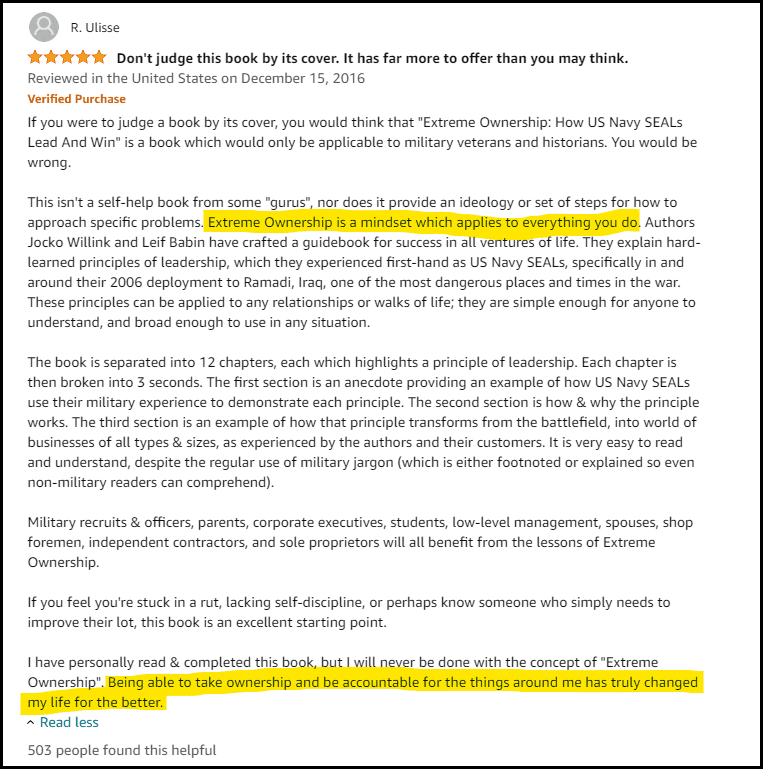
I’m writing a new book about remote leadership, and this is part of a series of posts that summarize some of the world’s best books on the topic. If you’d like to get an update every time I publish a new article, click here.
I recently finished reading “Extreme Ownership: How U.S. Navy SEALs Lead and Win” by Jocko Willink and Leif Babin, and here are a few takeaways from the book that I found quite insightful.
Extreme Ownership: A Quick Summary
Great leaders take complete ownership of everything that is assigned to them. They don’t just own the things they’re responsible for, but they also own all the elements that affect their mission.
The essence of the “Extreme Ownership” mindset is that effective leaders don’t point fingers or make excuses. They solve problems instead of complaining about setbacks. They do what needs to be done to get the job done, including leveraging relationships and assets.
The concepts are based on Willink’s and Babin’s experiences as United States Navy SEAL combat officers in Iraq (during Operation Iraqi Freedom) and business consultants through their leadership and management consulting company, Echelon Front LLC.
Extreme Ownership: Basic Concepts
The book is structured into three parts: :
- Part 1: Winning the War Within: This is about the mindset needed to win (it’s internally focused about developing the important building blocks). The chapters include: Extreme Ownership; No Bad Teams, Only Bad Leaders; Believe; Check the Ego.
- Part 2: The Laws of Combat: This focuses on four critical concepts that help a team perform. They include: Cover and Move; Simple; Prioritize and Execute; Decentralized Command.
- Part 3: Sustaining Victory: This addresses the tricky balance that leaders should continue to navigate in the future. The chapters include: Plan; Leading Up and Down the Chain of Command, Decisiveness amid Uncertainty; Discipline Equals Freedom – The Dichotomy of Leadership
Each chapter covers three subsections: a leadership lesson, a leadership principle, and an application to a business setting.
Extreme Ownership: Three Main Takeaways for Remote Leaders
Here are three main takeaways that I thought were quite insightful from the book, and some tactical applications that would apply to remote leaders.
#1 Lead down the chain
Information at the top of the organization does not automatically translate to frontline troops. Leaders frequently assume that strategies are intuitive and obvious to their subordinates, but they rarely are. Although soldiers should be focused on their tactical mission, they should also understand how their role and tasks contribute to the bigger picture. Leaders should explain the “Commander’s Intent” to empower them to make decisions and prioritize their efforts when things shift.
Tactical tip for remote leaders: During staff calls and 1:1 meetings, take the time to explain to your employees how their role contributes to the organization’s mission. Help them connect the dots between what they do every day and how their work adds value to the team and company. This keeps them motivated and gives them a decision framework to make important decisions when the environment changes.
#2 Lead up the chain
The only person to blame if your own boss is not making a timely decision or giving you the support your need is yourself. The onus is on you to manage up and do a better job to explain the information needed so that they can better support you. You lead everyone – subordinates, peers, and superiors. However, understand that your leader might have other competing priorities, and you must continue to support them even if you disagree. Most importantly, avoid a public display of disagreement and always present a unified front to your employees to avoid undermining your leader’s authority (this can be catastrophic to team morale and performance).
Tactical tip for remote leaders: Make sure your leadership team, including your direct boss, has “situational awareness” of what your concerns and priorities are. Keep them posted on a weekly or bi-weekly basis about your top-of-mind items, and guide them on what you want to do (instead of asking them what you should do). If there is any disagreement with your leader about a decision (this will always happen), make sure you continue to support them and avoid disagreeing publicly.
#3 Simplify your plans
Plans and orders that are complex lead to confusion, and things can easily spiral out of control. Leaders should communicate actions simply and clearly so that their troops fully understand what is required from them.
If a single person on your team doesn’t get it, you have failed as a leader, and it is your responsibility to make sure that they fully understand the mission and task.
Tactical tip for remote leaders: Simplify your plans and actions as much as possible before you assign them to your employees. And when you do make the assignment, encourage your team members to ask questions to clarify expectations. Take the time to re-explain and verify understanding by everyone.
Extreme Ownership: Notable Reviews and Popular Highlights
The book is a New York Times Bestseller and is highly reviewed on Amazon, with over 15,000+ ratings that are generally positive.

Here’s one of the top reviews about the book, highlighting the point about Extreme Ownership.

And among the popular highlights, a unique feature in Amazon Kindle books that shows what most people found helpful, here is one section of the book highlighted over 10,000 times.
On any team, in any organization, all responsibility for success and failure rests with the leader. The leader must own everything in his or her world. There is no one else to blame. The leader must acknowledge mistakes and admit failures, take ownership of them, and develop a plan to win.”
Extreme Ownership: How U.S. Navy SEALs Lead and Win
Would you like to get updates about other leadership books?
I’m writing a new book about remote leadership, and this is part of a series of posts that summarize some of the world’s best books on the topic.
If you’d like to get an update every time I publish a new book summary, click here.

